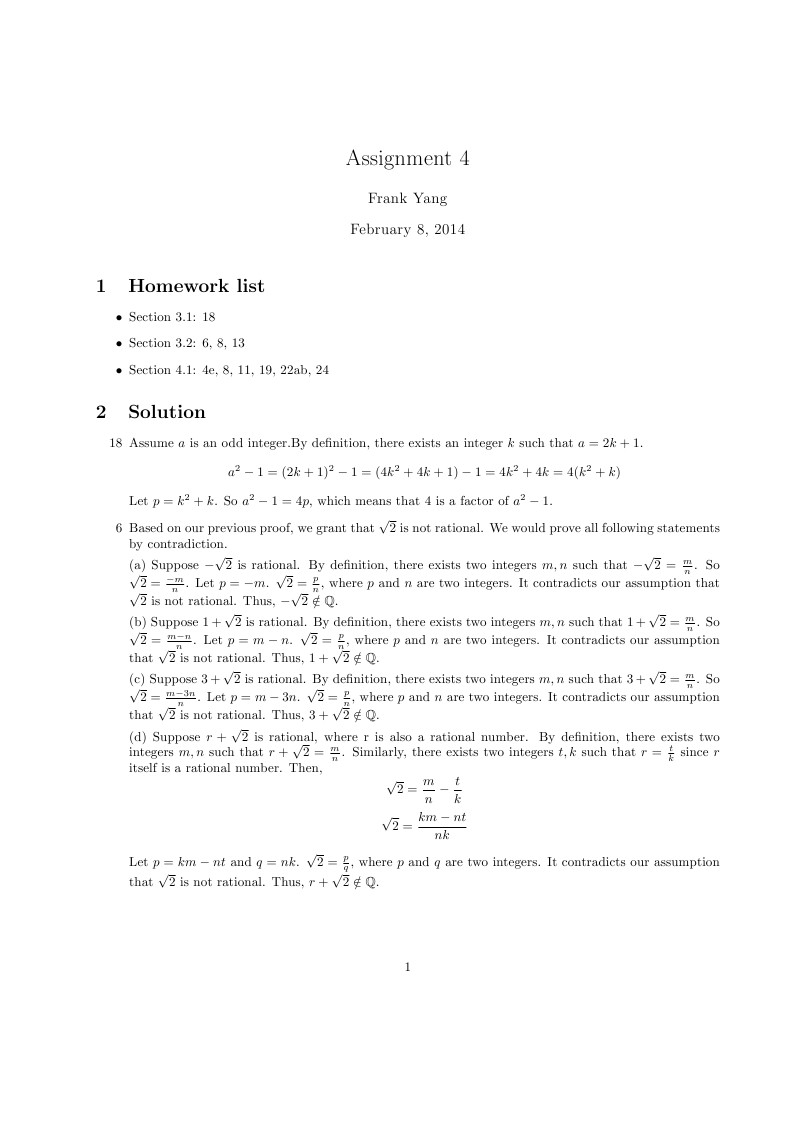
Assignment 4
Author:
Frank Yang
Last Updated:
12 лет назад
License:
Other (as stated in the work)
Аннотация:
Assignment for Math Structure

\begin
Discover why over 20 million people worldwide trust Overleaf with their work.

\begin
Discover why over 20 million people worldwide trust Overleaf with their work.
\documentclass[a4paper]{article}
\usepackage{amsmath,amsfonts}
\setlength{\oddsidemargin}{0in}
\setlength{\textwidth}{6.5in}
\setlength{\topmargin}{0in}
\setlength{\headheight}{0in}
\setlength{\headsep}{0in}
\setlength{\textheight}{8.7in}
\usepackage[english]{babel}
\usepackage[utf8x]{inputenc}
\usepackage{amsmath}
\usepackage{graphicx}
\usepackage[colorinlistoftodos]{todonotes}
\title{Assignment 4}
\author{Frank Yang}
\begin{document}
\maketitle
\section{Homework list}
\begin{itemize}
\item Section 3.1: 18
\item Section 3.2: 6, 8, 13
\item Section 4.1: 4e, 8, 11, 19, 22ab, 24
\end{itemize}
\section{Solution}
\begin{enumerate}
\item[18]
Assume $a$ is an odd integer.By definition, there exists an integer $k$ such that $a=2k+1$.
$$a^2-1=(2k+1)^2-1=(4k^2+4k+1)-1=4k^2+4k=4(k^2+k)$$
Let $p=k^2+k$. So $a^2-1=4p$, which means that $4$ is a factor of $a^2-1$.
\item[6]
Based on our previous proof, we grant that $\sqrt{2}$ is not rational.
We would prove all following statements by contradiction.
(a) Suppose $-\sqrt{2}$ is rational. By definition, there exists two integers $m,n$ such that $-\sqrt{2}=\frac{m}{n}$. So $\sqrt{2}=\frac{-m}{n}$. Let $p=-m$. $\sqrt{2}=\frac{p}{n}$, where $p$ and $n$ are two integers. It contradicts our assumption that $\sqrt{2}$ is not rational. Thus, $-\sqrt{2} \notin \mathbb{Q}$.
(b) Suppose $1+\sqrt{2}$ is rational. By definition, there exists two integers $m,n$ such that $1+\sqrt{2}=\frac{m}{n}$. So $\sqrt{2}=\frac{m-n}{n}$. Let $p=m-n$. $\sqrt{2}=\frac{p}{n}$, where $p$ and $n$ are two integers. It contradicts our assumption that $\sqrt{2}$ is not rational. Thus, $1+\sqrt{2} \notin \mathbb{Q}$.
(c) Suppose $3+\sqrt{2}$ is rational. By definition, there exists two integers $m,n$ such that $3+\sqrt{2}=\frac{m}{n}$. So $\sqrt{2}=\frac{m-3n}{n}$. Let $p=m-3n$. $\sqrt{2}=\frac{p}{n}$, where $p$ and $n$ are two integers. It contradicts our assumption that $\sqrt{2}$ is not rational. Thus, $3+\sqrt{2} \notin \mathbb{Q}$.
(d) Suppose $r+\sqrt{2}$ is rational, where r is also a rational number. By definition, there exists two integers $m,n$ such that $r+\sqrt{2}=\frac{m}{n}$. Similarly, there exists two integers $t,k$ such that $r=\frac{t}{k}$ since $r$ itself is a rational number. Then,
$$\sqrt{2}=\frac{m}{n}-\frac{t}{k}$$
$$\sqrt{2}=\frac{km-nt}{nk}$$
Let $p=km-nt$ and $q=nk$. $\sqrt{2}=\frac{p}{q}$, where $p$ and $q$ are two integers. It contradicts our assumption that $\sqrt{2}$ is not rational. Thus, $r+\sqrt{2} \notin \mathbb{Q}$.
\item[8]
We give a proof by contradiction.
Assume $\log_{2}(5)$ is rational. By definition,there exists two integers $m,n$ such that $\log_{2}(5)=\frac{m}{n}$. Then,
$$2^{\log_{2}(5)}=2^{\frac{m}{n}}$$
$$5=2^{\frac{m}{n}}$$
$$5^{n}=2^{m}$$
Apparently, $5^{n}$ is odd and $2^{m}$ is even. $5^{n}$ can never equal to $2^{m}$ for any two integers $m,n$.
Thus, $\log_{2}(5)$ is not rational.
\item[13]
We give a proof by contradiction.
Assume $rx$ is rational, where r is a rational number but $\neq 0$ and x is not rational. By definition, there exists two integers $m,n$ such that $rx=\frac{m}{n}$. Similarly, there exists two integers $t,k$ such that $r=\frac{t}{k}$, since $r$ itself is a rational number. And since $r \neq 0$, $t$ is not $0$.
Then,
$$rx=\frac{tx}{k}=\frac{m}{n}$$
$$txn=mk$$
$$x=\frac{mk}{tn}$$
Let $p=mk$ and $q=tn$. $x=\frac{p}{q}$, where $p$ and $q$ are two integers. It contradicts our assumption that x is not a rational number. Thus, if $r$ is rational and $\neq 0$ and $x$ is irrational, then $rx$ is irrational.
\item[4e]
$(A-C)=(A-B)\cup(B-C)$ is not true.
Assume $A=\left\{{1,2}\right\}$ $B=\left\{{2,3}\right\}$ $C=\left\{{1,3}\right\}$
$(A-C)=\left\{{2}\right\}$ $(B-C)=\left\{{2}\right\}$ $(A-B)=\left\{{1}\right\}$
$(A-B)\cup(B-C)=\left\{{1,2}\right\} \neq (A-C)$
Salveage: $(A-C) \subseteq (A-B)\cup(B-C)$
Proof: Assume $x \in (A-C)$. Then, $x \in A$ and $x \notin C$. Either $x \in B$ or $x \notin B$. So, either $x \in B$ and $\notin C$, or $x \notin B$ and $x \in A$. So $x \in (B-C)$ or $x \in (A-B)$. So $x \in (A-B)\cup(B-C)$. Thus, $(A-C) \subseteq (A-B)\cup(B-C)$
\item[8]
(a) Assume $A \subseteq B$. So for all set $X$ that $X \subseteq A$, $X \subseteq B$. Since every element in $P(A)$ must be an subset of $A$, which means it must be an subset of $B$. And every subset of $B$ $\in P(B)$. So every element in $P(A)$ is also an element in $P(B)$. Thus, $P(A) \subseteq P(B)$.
(b) By definition, for all element $X \in P(A \cap B)$, $X \subseteq (A \cap B)$. So, $X \subseteq A$ and $X \subseteq B$. Since $X \subseteq A$, $X \in P(A)$. Similarly, since $X \subseteq B$, $X \in P(B)$. So $X \in (P(A) \cap P(B)) $. Thus $P(A \cap B) \subseteq (P(A) \cap P(B))$. Since all previous steps are reversible. $(P(A) \cap P(B)) \subseteq P(A \cap B)$. Thus $P(A \cap B) = P(A) \cap P(B)$.
(c) $P(A \cup B)= P(A) \cup P(B)$
By definition, for all element $X \in P(A \cup B)$, $X \subseteq (A \cup B)$. So, $X \subseteq A$ or $X \subseteq B$. So $X \in P(A)$ or $X \in P(B)$. So $X \in (P(A) \cup P(B)) $. Thus $P(A \cup B) \subseteq (P(A) \cup P(B))$. Since all previous steps are reversible. $(P(A) \cup P(B)) \subseteq P(A \cup B)$. Thus $P(A \cup B) = P(A) \cup P(B)$.
\item[11]
On the last page.
\item[19]
Proof by contrapositive:
Assume $B \neq C$. There exists an element $x$ that ($x$ in $B$ but not in $C$) or ($x$ in $C$ but not in $B$). Because $B$ and $C$ are symmetrical in this statement (swatching $B$ and $C$ will give us same proposition). Just assume $x$ in $B$ but not in $C$. For an element $a \in A$, the ordered pair $(a,x)$ will be in $A \times B$ but not in $A \times C$, since $x \notin C$. So $A \times B \neq A\times C$. Thus, if $A \times B= A\times C$, $B = C$.
\item[22a]
True.
Assume ordered pair $(p,q) \in A \times (B-C)$. So $p \in A$ and $q \in B$ and $q \notin C$. So $(p,q) \in A \times B$ and $(p,q) \notin A \times C$. So $(p,q) \in (A \times B - A\times C)$. Thus, $A \times (B-C) \subseteq A \times B - A\times C$. Since previous steps are all reversible, $A \times B - A\times C\subseteq A \times (B-C)$. So $A \times (B-C) = A \times B - A\times C$.
\item[22b]
False.
Counterexample:
Assume $A=\left\{{1}\right\}$
$B=\left\{{2}\right\}$
$U=\left\{{1,2}\right\}$
$A \times B =\left\{{(1,2)}\right\}$
$U^2=\left\{{(1,1),(1,2),(2,1),(2,2)}\right\}$
$(A \times B)^{c}=\left\{{(1,1),(2,1),(2,2)}\right\}$
$A^{c} \times B^{c}=\left\{{(2,1)}\right\}$
Thus, $(A \times B)^{c} \neq A^{c} \times B^{c}$.
\item[24]
(a)$\left\{{[0,1],[1,2],[2,3],[3,4],[4,5],[5,6],[6,7],[7,8],[8,9],[9,10],[10,11]}\right\}$
(b) $B_{1}=(0,2)$, $B_{10}=(0.9,1.1)$, $B_{100}=(0.99,1.01)$
\end{enumerate}
\end{document}